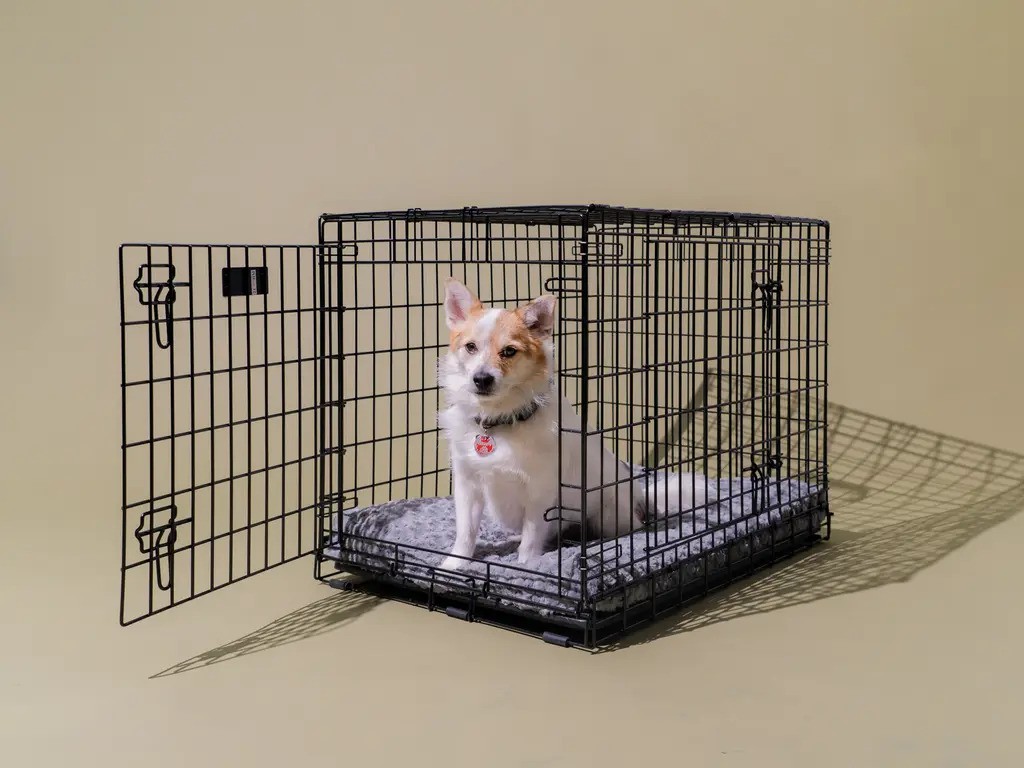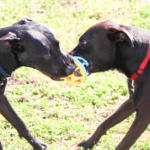Crate train an adult dog without force by creating positive associations with the crate. Place soft bedding inside, use treats or toys to encourage entry, and keep the door open at first. Gradually increase crate time while rewarding calm behavior. Never use the crate as punishment, and always build trust through patience.
Why Adult Dogs Need Different Crate Training
Adult dogs process crate training differently from puppies due to their developed cognitive abilities and established behavioral patterns. Unlike puppies who approach new experiences with natural curiosity, mature dogs often bring their past experiences – both positive and negative – into the training process.
Past experiences shape behavior
Previous encounters with crates significantly influence an adult dog’s response to training. Some dogs might have faced forced confinement during transport or unsuccessful crate training attempts in their previous homes. Furthermore, certain adult dogs develop negative associations with crates, requiring additional patience and positive reinforcement during the retraining process.
Dogs are naturally den animals, seeking enclosed spaces for safety and comfort. In the wild, canids dig dens for various purposes – from sheltering their puppies to finding refuge during harsh weather. Nevertheless, adult dogs who have never experienced proper crate training might initially resist this natural instinct due to negative experiences or lack of exposure.
Common challenges with older dogs
Adult dogs face distinct obstacles during crate training that puppies typically don’t encounter. First, mature dogs have more developed brains and established habits, making them potentially more resistant to changes in their routine. This resistance stems from their tendency to be creatures of habit, requiring careful unlearning of old behaviors before adopting new ones.
Separation anxiety presents another significant challenge. Some adult dogs become extremely distressed when left alone in a crate, displaying behaviors such as:
- Excessive whining and barking
- Attempting to break out of the crate
- Showing signs of stress or anxiety
- Refusing to enter the crate voluntarily
Setting Up for Success
Proper setup forms the foundation for successful crate training with your adult dog. A well-planned approach considering crate size, comfort, and location significantly impacts your dog’s acceptance of their new space.
Choosing the right crate size
The crate must allow your dog to:
- Stand comfortably without ducking
- Turn around easily
- Lie down with fully extended limbs
- Maintain at least 2 inches of head clearance when sitting
Although spacious quarters might seem appealing, oversized crates can hinder training progress. A crate that’s too large might encourage your dog to use one end as a bathroom area. Accordingly, select a size that provides comfort without excess space.
Creating a cozy den environment
For dogs who don’t regularly chew fabric items, place a comfortable, machine-washable bed or mat inside the crate. Nonetheless, some adult dogs might prefer the bare crate surface. Start with basic bedding options, as your dog might damage expensive items during the adjustment period.
Proper ventilation plays a crucial role in creating a comfortable space. Wire crates offer excellent airflow and visibility, making them ideal for most dogs. Meanwhile, dogs preferring darker, more enclosed spaces might benefit from kennel-style crates.
Picking the perfect location
Consider these factors when choosing the crate location:
- Select a quiet spot away from direct sunlight
- Avoid placing near heating or cooling vents
- Keep the crate visible from common areas
- Ensure the area has consistent temperature
For multi-dog households, each dog requires their own crate. This arrangement prevents potential conflicts and gives each pet their personal space. Furthermore, reinforce all crate edges with zip ties to prevent escape attempts, regardless of your dog’s previous crate behavior.
Building Trust Before Training
Patience forms the cornerstone of successful crate training for adult dogs. First, we need to establish trust and positive associations before diving into formal training sessions.
Let your dog explore freely
To encourage natural curiosity:
- Place treats randomly inside the crate when your dog isn’t looking
- Drop high-value treats near the entrance
- Position favorite toys inside
- Keep the crate door secured in an open position
Remember that some dogs might take several days or even weeks to approach the crate willingly. Avoid showing disappointment or anxiety if your dog seems hesitant, as they can pick up on these emotions and develop increased resistance.
Using treats as positive markers
Selecting appropriate treats plays a vital role in building positive crate associations. Consider these treat options:
- Quick-reward treats: Use small, easily consumable treats for immediate reinforcement
- Long-lasting options: Incorporate marrow-filled bones or bully sticks for extended crate time
- Single-ingredient treats: Choose treats without additives or preservatives
Begin by tossing treats toward the back of the crate, allowing your dog to retrieve them voluntarily. As your dog grows more comfortable, start placing longer-lasting treats inside to encourage extended stays. Should your dog remove the treat from the crate, avoid correcting this behavior – simply try again later.
Starting with Small Steps
Short training sessions create lasting success when crate training adult dogs. By breaking down the process into manageable steps, we help our dogs build confidence naturally.
5-minute comfort sessions
Begin with brief 5-10 minute sessions to help your dog adjust to the crate environment. These short periods prevent overwhelming your pet and allow them to process new experiences positively. Throughout these initial sessions, maintain a cheerful demeanor as your dog’s comfort level grows.
For optimal results, scatter treats inside the crate when your dog isn’t watching. This approach creates an element of discovery, making the crate more intriguing. Once your dog ventures inside, offer immediate praise without closing the door. Consequently, this builds trust and encourages repeated entries.
Feeding meals near the crate
Once your dog enters confidently, try these steps:
- Place food at the back of the crate
- Close the door briefly while they eat
- Open it immediately after they finish
- Steadily increase door-closed duration
Some dogs might initially resist eating in their crate. In such cases, consider alternative feeding locations temporarily while maintaining other aspects of crate training. Interestingly, reducing mealtime pressure sometimes leads to increased crate acceptance.
Playing crate games
One effective game involves using a stuffed KONG toy tied to the crate’s back. This setup encourages extended crate time while providing entertainment. Additionally, incorporate high-value treats like small pieces of sausage or cookies to maintain enthusiasm.
When introducing crate games, remember these key principles:
- Maintain an excited, positive attitude
- Reward desired behaviors immediately
- Ignore mistakes instead of punishing
- Review previous skills before teaching new ones
Consider starting with the “Where’d It Go?” game, which proves particularly effective. Similarly, the “Look at Me” exercise helps dogs maintain focus despite distractions, strengthening their connection to the crate space.
Extending Crate Time Gradually
Once your dog shows consistent comfort with short crate sessions, gradually increasing their time inside becomes the next crucial step. This phase requires careful observation and respect for your dog’s individual pace.
Adding 5 minutes each session
For longer stays, provide engaging activities inside the crate:
- Frozen stuffed KONGs that last 15-20 minutes
- Safe, long-lasting chew toys
- Favorite comfort items
Maintain consistency by opening the crate door before any signs of distress appear. This proactive approach prevents negative associations and builds trust. Once your dog handles shorter periods well, steadily work toward extended durations.
Reading your dog’s comfort signals
Understanding your dog’s body language helps determine their readiness for increased crate time. Watch for these positive indicators:
- Entering the crate voluntarily
- Settling down quickly
- Maintaining calm behavior
- Showing enthusiasm for crate-related activities
Alternatively, certain behaviors signal that your dog needs more time to adjust:
- Crying or barking beyond one minute
- Excessive pacing inside the crate
- Showing signs of anxiety
- Attempting to break out
Should these stress signals appear, immediately return to shorter durations where your dog previously succeeded. This step-back approach maintains progress while respecting their comfort level.
Dealing with Common Problems
Even well-trained adult dogs occasionally face challenges with crate training. Understanding common issues helps address them effectively without causing additional stress to your pet.
Whining and barking solutions
For attention-seeking behavior:
- Ignore the whining completely
- Reward quiet moments with treats
- Maintain consistent response patterns
- Return only after periods of silence
Some dogs vocalize because of genuine distress. In these cases, forcing them to “cry it out” might worsen anxiety. Consider alternative confinement options like puppy pens attached to the crate entrance, allowing more freedom while maintaining boundaries.
Anxiety management techniques
Separation anxiety manifests differently from standard crate resistance. Dogs experiencing separation anxiety typically show signs only when left alone, remaining calm in the crate while their owners stay nearby.
To manage anxiety effectively:
- Start with brief absences, gradually extending time away
- Use calming aids like interactive toys or puzzle feeders
- Consider incorporating a white noise machine
- Place familiar scented items in the crate
When to take a step back
Recognizing signs of distress helps prevent negative associations with the crate. Watch for these warning signals:
- Excessive pawing or chewing at crate bars
- Prolonged attempts to escape
- Self-destructive behavior
- Complete food refusal in the crate
Upon noticing these behaviors, immediately reassess your training approach. Sometimes, dogs require alternative confinement methods while rebuilding positive crate associations. Consider using a larger pen or dog-proofed room temporarily.
Conclusion
Crate training adult dogs demands patience, understanding, and consistent positive reinforcement. Though older dogs might take longer to adjust compared to puppies, their ability to focus and learn makes success achievable through gentle methods.
Remember that each dog progresses differently based on their past experiences and personality. Some might embrace their crate within days, while others need weeks or months to feel completely comfortable. Certainly, rushing the process often leads to setbacks that could damage your dog’s trust.
Most importantly, celebrate small victories along your crate training journey. Whether your dog takes their first treat inside the crate or sleeps peacefully through the night, these moments signal growing confidence. Stay committed to positive reinforcement, respect your dog’s pace, and watch as their crate transforms into a cherished safe space.
I’ve loved dogs all my life and have cared for many different breeds over the years. Here, I share simple tips, stories, and helpful advice for all dog lovers. Whether you’re a new pet parent or a lifelong dog fan, you’ll find something useful and fun on my site.


